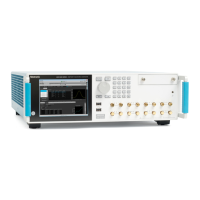Specifications
Table 7: Signal output characteristics (cont.)
Characteristics Description
VSWR
Output path
DC High BW
(Includes option DC
Amplified)
DC to 1 GHz < 1.25:1
1GHzto3GHz<1.9:1
3GHzto4GHz<2.3:1
DC High Voltage
(Option HV)
DC to 400 MHz < 1.6:1
400 MHz to 1 G Hz < 1.75:1
1GHzto2GHz<2.3:1
AC Direct
10 MHz to 300 MHz < 2.0:1
300 MHz to 1.4 G Hz <1.6:1
1.4GHzto3GHz<2.2:1
3GHzto4GHz<2.5:1
AC Amplified
(Option AC)
10 MHz to 500 MHz < 2.4:1
500 MHz to 1.5 GHz < 1.75:1
1.5GHzto4GHz<1.9:1
Output Modes
NRZ
In NRZ mode, each sample is held for the entire sample period ( 1/sample rate). This results
in the familiar sin(x)/x frequency response. With DDR mode enabled, the sin(x)/x bandwidth
doubles.
RZ
In RZ mode, each sample is held for half of the sample period. This doubles the sin(x)/x
bandwidth, but reduces the amplitude by half. This may be useful when playing a real
waveform with the signal in the second Nyquist zone. For real waveforms, DDR m ode filters
the signal in the 2nd and 3rd Nyquist zones and is not useful in this case.
MIX M ode
In Mix mode, each sample is inverted for the second half of the sample period. This is
effectively like mixing the output waveform with the sample clock. T his boosts the s ignal in
the second Nyquist zone, but zeros the DC component of the waveform and reduces low
frequency components. This may be useful when playing a real waveform with the s ignal in
the second Nyquist zone. For real waveforms, DDR m ode filters the signal in the 2nd and 3rd
Nyquist zones and is not useful in this case.
Sin(x)/x Bandwidth 4.44 GHz * fsample ÷ 10 GS/s (DDR Mode).
fsample = sample rate.
The sin(x)/x bandwidth can be solved by using the following equation:
20 * log (sin(x)/x) = –3.
x=π * fout ÷ fsample.
fsample = sample rate.
fout = sin(x)/x bandwidth.
Amplitude control
Independent amplitude control for all channels.
Units of dBm or V can be selected.
6 AWG5200 Series Technical Reference

